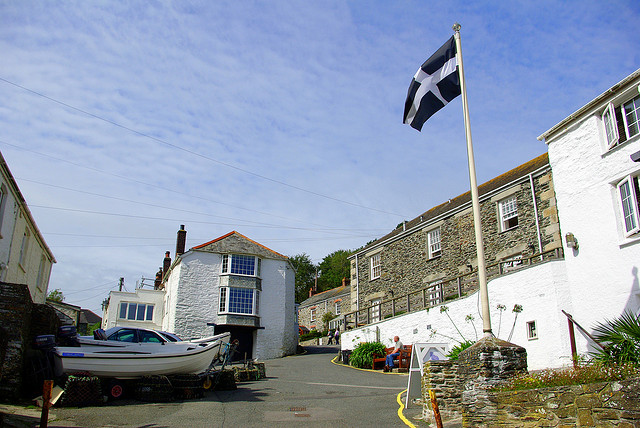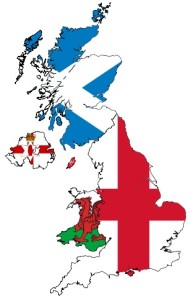The implications of Scotland’s independence referendum – for Cornwall
The publication of the Scottish Government’s White Paper has refocused British political attention north of the border. However, there could be implications elsewhere. Cornwall, too, has always had a strong regional – and indeed national – identity, which could see demands for self-government rise should Scotland opt for the UK’s exit door, according to Peder Clark.
As the countdown to 18 September 2014 intensifies with the publication of the Scottish Government’s white paper Scotland’s Future, the ripples emanating from the prospect of a referendum have been felt at the opposite end of the UK. The Times last year ran a feature on Cornish nationalism with the headline “Could Cornwall go the same way as Scotland?” which whilst a reduction of the issue, suggests a natural link. Professor Philip Payton, Director of Cornish Studies at the University of Exeter, reports increased interest from a number of national newspapers, and poses the question:
”If Scotland becomes independent, then what is Cornwall? How does that fit into the remnant? Cornwall will look even more different, in a rump UK without Scotland … Is it more like Wales, is it part of England? At that time, people in Cornwall who have been quite happy in a blurred identity, with the St Piran’s flag and the Union flag flying side by side, may have to make some choices about identity”.
Cornwall currently has a population of around 537,400 including the Isles of Scilly, but is amongst the fastest growing areas of the UK, with an expectation that it will expand to 630,300 in the next decade. This growth is primarily due to migration, although there has also been a recent trend for young people to stay in Cornwall, helping to further swell the population. This immigration has been the subject of a good deal of disgruntlement. As in so many popular debates about migration, the statistics can happily be ignored or distorted. While the influx over the last half a century is mostly attributable to a younger, working-age demographic, the ‘stubborn myths of retirement migration’ persist. A popular view, even amongst the well-informed native population is that Cornwall is fast becoming “a playground for people from elsewhere with money”.
Some of these mild prejudices are born out in the high number of second homes in Cornwall, resulting in house prices that correlate poorly with wages. Allied to the manner in which tourism has become the dominant industry, and it is understandable that the Cornish might feel aggrieved, and how this might reinforce, and be reinforced by, already existing regional consciousness. But how is this distinct from any other county with a strong regional identity, such as Yorkshire?
In the 2011 England and Wales census, 73,220 people in Cornwall self-identified as ‘Cornish’. This represents 13.8% of the population, compared to a figure of 6.8% in the 2001 census, following Cornwall Council’s awareness-raising campaign, which gave guidance to people wishing to identify themselves as ‘Cornish’. Other surveys conducted in the last decade have demonstrated further evidence of a significant sense of Cornish identity in the region. A study conducted by Morgan Stanley in 2004 asked people across Britain whether their primary identification was as European, British, English or to their county. Cornwall recorded the highest percentage of people relating to their local identity most strongly, with 44 per cent. A postal survey conducted by the Council in the same year yielded 35 per cent of the 4,052 respondents opting for Cornish as their ethnicity. These statistics demonstrate a regional consciousness incomparable to other English counties, and might lead one to examine whether it is more comparable to the Celtic nations of the United Kingdom, or other regions of Europe that exhibit strong regional identity.
Three separate studies of Cornish identity since 2008 by Joanie Willett, Robert Dickinson and Kerryn Husk, look in more depth into what being ‘Cornish’ might signify. The first, by Willett, attempts to establish whether Cornish identity is no more than a vague notion, or if it can be classed as a ‘social fact’. This is a sociological concept introduced by Emile Durkheim, in which scientific empirical investigation can establish social phenomena as “things by the same right as material things, although they differ from them in type”. These social facts exist on a graduated scale, from being a ‘morphological fact’, fully integrated into collective life, through to ‘institutionalised norms’ or ‘social currents’, where the sociological concept is an established element of life, but not a primary identity. Finally, and most weakly, the lowest rung of the scale are ‘transitory outbreaks’, or momentary bouts of enthusiasm, which arguably might describe the trips to Twickenham by Cornish supporters (nicknamed Trelawny’s Army) in the early to mid-1990s when Cornwall repeatedly reached the final of the County Championship, a favoured point of reference for scholars of Cornish nationalism.
Willett attempts to apply these theories to the everyday concept of ‘Cornishness’ by surveying a small sample cross-section population across Cornwall, and concludes that Cornish identity is best described as an institutionalised norm. This seems a counterfactual conclusion considering the evidence that there are few Cornish institutions per se, but her questionnaire and focus groups does identify that for those born and bred in Cornwall, the idea of being Cornish has significant relevance, but interestingly, is not necessarily exclusive of being British, or even English. Willett also believes her research demonstrates that Cornishness is “dynamic, with newcomers socialised and assimilated into the identity”, an assertion that is repudiated by the beliefs of the indigenously Cornish described in Dickinson’s work.
Dickinson’s filter is to examine Cornish social representations (i.e. the ‘commonsense knowledge’ that communities share and gives them cohesion), by undertaking semi-structured interviews with farming communities. Many had deeply entrenched ideas about Cornish identity, and what qualified an individual to describe oneself as Cornish:
“Jeremy put it vividly: ‘They say that to be accepted as Cornish you’ve got to have your grandfather in the graveyard, that’s an old saying. You’ve got to be two or three generations before you’re called Cornish”
Despite these firm opinions, and despite the fact that all interviewees self-identified as Cornish (whether or not they complied with the strict criteria stated above), and were certainly discontented at both the perceived ‘English’ and a disappearing cultural identity, the majority were unwilling to paint themselves in Hobsbawm’s “attractive colours of Celtic tradition”. Most were reticent to engage with Cornish cultural or language groups, and were equivocal about the gaudier aspects of the ‘Cornish revival’ such as Kernow car-stickers or the anachronistic Cornish tartan. Unfortunately Dickinson does not explore the political views of the group, save for an interviewee mentioning the late Cornish MP David Penhaligon as the embodiment of Cornishness. Nonetheless, his study illustrates that a firmly held identity might not readily translate into demonstrable or political expression.
Husk meanwhile draws explicit connections to theories of nationalism. While Willett alludes briefly to the work of Anthony Smith and Benedict Anderson’s ‘imagined communities’, Husk examines her findings through Smith’s idea of ethnie, described in his 1986 book The Ethnic Origins of Nations. Smith laments that the English language contains no word to describe an ethnic group or community, and so appropriates the French term, which he believes “capture[s] the peculiar cultural individuality and shared historicity of ethnicity”.
He details the defining features of ethnie as comprising; a collective name, a common myth of descent, a shared history, a distinctive shared culture, an association with a specific territory and a sense of solidarity. Husk takes this conceptual framework and attempts to apply it to the Cornish, with the conclusion that they satisfy this criteria and can comfortably be described as a discrete ethnie: “The group exists, and exists in significant numbers, highlighting the need to examine them in detail”.
Indeed, there is a vibrant research community centred around the Institute of Cornish Studies at Exeter University doing just that, but the Cornish ethnie cannot be studied in isolation from Cornwall’s administrative status as an English county, or its historical affinity with the UK’s ‘Celtic’ nations. Dependent on the outcome of the Scottish referendum, Cornish regional identity and nationalist rhetoric may be viewed very differently in a post-2014 world.
—
Note: This piece is based on an article for the Cornish Studies Journal. It represents the views of the author, and not those of Democratic Audit or the LSE. Please read our comments policy before posting. The shortened URL for this post is: https://buff.ly/180NsPZ
—
 Peder Clark is a contributor to Cornish Studies. His study of the roots and history of Cornish nationalism was published in the 21st edition of Cornish Studies. This article is an edited extract. He has an MA in Contemporary History and Politics from Birkbeck College, London.
Peder Clark is a contributor to Cornish Studies. His study of the roots and history of Cornish nationalism was published in the 21st edition of Cornish Studies. This article is an edited extract. He has an MA in Contemporary History and Politics from Birkbeck College, London.







 Democratic Audit's core funding is provided by the Joseph Rowntree Charitable Trust. Additional funding is provided by the London School of Economics.
Democratic Audit's core funding is provided by the Joseph Rowntree Charitable Trust. Additional funding is provided by the London School of Economics.
“@eurorights: Interesting blog on ‘The implications of Scotland’s independence referendum – for Cornwall’ @VilaWeb https://t.co/zfC42qb8MJ“
Interesting blog on ‘The implications of Scotland’s independence referendum – for Cornwall’ @democraticaudit https://t.co/A2yo8Ne6su
Interesting article but I wonder why it isn’t listed in your Future of the Union section.
Thanks for the comment Fulub. This is part of the Future of the Union series. We neglected to put in the link to the series but have now corrected this. Thanks.
The implications of Scotland’s independence referendum – for #Cornwall https://t.co/PlY4Tzmi8Q
Bledhen noweth da, to all readers. An interesting identity piece to start the year:… https://t.co/0lGqhwCdPS
The implications of Scotland’s independence referendum – for Cornwall https://t.co/ZuBesR6zC0
“@JamesKerLindsay: #Scotland #independence may encourage #Wales secession. #Cornwall too? https://t.co/gxA10IjfFk @democraticaudit”
#Scotland #independence may encourage #Wales secession. But could it affect #Cornwall too? https://t.co/5K0anpghiT @democraticaudit
Aren’t you missing the “Elephant in the room?” and tinkering around the edges?
The true UK constitutional status of the Duchy of Cornwall seems to me to far more significant to Cornwall’s identity, and for that matter, existing, if not recognised, “separateness” from England.